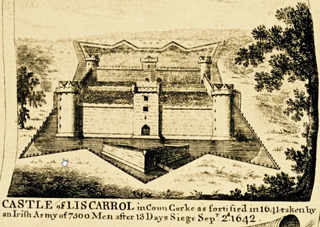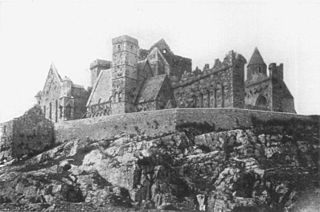
The Rock of Cashel, also known as Cashel of the Kings and St. Patrick's Rock, is a historical site located at Cashel, County Tipperary, Ireland.

The Irish Confederate Wars, also called the Eleven Years' War, took place in Ireland between 1641 and 1653. It was the Irish theatre of the Wars of the Three Kingdoms, a series of civil wars in the kingdoms of Ireland, England and Scotland – all ruled by Charles I. The conflict had political, religious and ethnic aspects and was fought over governance, land ownership, religious freedom and religious discrimination. The main issues were whether Irish Catholics or British Protestants held most political power and owned most of the land, and whether Ireland would be a self-governing kingdom under Charles I or subordinate to the parliament in England. It was the most destructive conflict in Irish history and caused 200,000–600,000 deaths from fighting as well as war-related famine and disease.

Confederate Ireland, also referred to as the Irish Catholic Confederation, was a period of Irish Catholic self-government between 1642 and 1652, during the Eleven Years' War. Formed by Catholic aristocrats, landed gentry, clergy and military leaders after the Irish Rebellion of 1641, the Confederates controlled up to two-thirds of Ireland from their base in Kilkenny; hence it is sometimes called the "Confederation of Kilkenny".

The Cromwellian conquest of Ireland (1649–1653) was the re-conquest of Ireland by the Commonwealth of England, led by Oliver Cromwell. It forms part of the 1641 to 1652 Irish Confederate Wars, and wider 1639 to 1653 Wars of the Three Kingdoms. Modern estimates suggest that during this period, Ireland experienced a demographic loss totalling around 15 to 20% of the pre-1641 population, due to fighting, famine and bubonic plague.
Alasdair Mac Colla Chiotaich MacDhòmhnaill, also known by the English variant of his name Sir Alexander MacDonald, was a military officer best known for his participation in the Wars of the Three Kingdoms, notably the Irish Confederate Wars and Montrose's Royalist campaign in Scotland during 1644–5. A member of the Gaelic gentry of the Clan MacDonald of Dunnyveg, a branch of the Clan Donald active in the Hebrides and Ireland, Mac Colla is particularly notable for the very large number of oral traditions and legends which his life inspired in the Highlands.

The Battle of Liscarroll was fought on 3 September 1642 in northern County Cork, Munster, between Irish Confederate and Royalist troops. The battle was part of the Irish Confederate Wars, which had started in the north in 1641 reaching Munster in 1642. The Confederates, about 8,500 strong, were led by Garret Barry, an Irish veteran from the Spanish Army of Flanders. The Royalist forces, about 2,400 strong, were commanded by Murrough O'Brien, 6th Baron of Inchiquin, an Irish Protestant. Despite his numerical disadvantage Inchiquin routed his enemies by the strength of his cavalry and the firepower of his musketeers.

The Battle of Rathmines was fought on 2 August 1649, near the modern Dublin suburb of Rathmines, during the Irish Confederate Wars, an associated conflict of 1638 to 1651 Wars of the Three Kingdoms. It has been described as the 'decisive battle of the Engagement in Ireland.'

Lieutenant-General Michael Jones, c. 1606 to 10 December 1649, was an Irish-born soldier of Welsh descent who fought for Parliament and the Commonwealth in the War of the Three Kingdoms, primarily in Ireland. Third son of Lewis Jones, Bishop of Killaloe, his brothers Henry and Ambrose were both bishops in the Protestant Church of Ireland.

Sir Donough MacCarty, 1st Earl of Clancarty (1594–1665), was an Irish soldier and politician. He succeeded his father as 2nd Viscount Muskerry in 1641. He rebelled against the government and joined the Irish Catholic Confederation, demanding religious freedom as a Catholic and defending the rights of the Gaelic nobility. Later, he supported the King against his Parliamentarian enemies during the Cromwellian conquest of Ireland.
Theobald Taaffe, 1st Earl of Carlingford, known as 2nd Viscount Taaffe, of Corren and 2nd Baron of Ballymote between 1642 and 1661, was an Irish Royalist officer who played a prominent part in the Wars of the Three Kingdoms. Following the outbreak of the Irish Rebellion of 1641, the Catholic Taaffe remained loyal to the authorities in Dublin. He later joined the Irish Confederates, and was awarded command of the Munster Army. Taaffe was a supporter of the moderate faction, and strongly supported an alliance between the Confederates and Irish Royalists. After the Cromwellian conquest of Ireland, Taaffe accompanied Charles II in exile. Following the Restoration, he was created 1st Earl of Carlingford.
Richard Townesend was a soldier and politician in England. He was born in 1618 or 1619. Much research has been undertaken by various members of the Townsend family to trace Richard's origins but nothing is known about him before 1643 when he was appointed to command a company, as a captain, in Colonel Ceely's Regiment, which had been raised to garrison Lyme Regis. Richard was engaged in several skirmishes, most notably on 3 March 1643 when he surprised and routed 150 Royalist cavalry at Bridport. Later, he was present during the defence of Lyme Regis 20 April – 13 June 1644 where he distinguished himself and was promoted to Major. In 1645 he assumed command of Colonel Ceely's Regt when Colonel Ceely was returned to Parliament as Member of Parliament (MP) for Bridport.
Events from the year 1647 in Ireland.
The Battle of Arklow was a minor skirmish that took place at Glascarrig on the coast road near Arklow in County Wicklow on 1 November 1649. It was fought between the army of the Parliamentarians and the combined forces of the Irish Royalists and Confederates during the Irish Confederate Wars.
Presented below is a chronology of the major events of the Irish Confederate Wars from 1641 to 1653. This conflict is also known as the Eleven Years War. The conflict began with the Irish Rebellion of 1641 and ended with the Cromwellian conquest of Ireland (1649–53).

The sack of Cashel, also known as the massacre of Cashel, took place on 15 September 1647 during the Irish Confederate Wars, when Cashel Castle in County Tipperary was taken by a Protestant Parliamentarian army commanded by the Baron of Inchiquin. In what is considered one of the most brutal incidents of the war, survivors of the Catholic garrison were executed along with a number of civilians and the castle was sacked.

Murrough MacDermod O'Brien, 1st Earl of Inchiquin, was an Irish nobleman and soldier, who came from one of the most powerful families in Munster. Known as Murchadh na dTóiteán, he initially trained for war in the Spanish service. He accompanied the Earl of Strafford into Leinster on the outbreak of the Irish Rebellion of 1641 and was appointed governor of Munster in 1642. He had some small success, but was hampered by lack of funds and he was outwitted by the Irish leader, Viscount Muskerry, at Cappoquin and Lismore. His forces dispersed at the truce of 1643.
The Battle of Dungan's Hill took place in County Meath, in eastern Ireland on 8 August 1647. It was fought between the armies of Confederate Ireland and the English Parliament during the Irish Confederate Wars. The Irish army was intercepted on a march towards Dublin and destroyed. Although it is a little-known event, even in Ireland, the battle was very bloody and had important political repercussions. The Parliamentarian victory there destroyed the Confederate Leinster Army and contributed to the collapse of the Confederate cause and the Cromwellian conquest of Ireland in 1649.

The Irish Confederate expedition to Scotland took place in 1644–1645 during the Wars of the Three Kingdoms. A force of about 2,000 Irish Confederate troops, under the command of Alasdair Mac Colla, sailed to Scotland in June 1644, where they joined with Royalist forces fighting Montrose's Highland campaign against the Covenanters. The expedition was the result of an effort by King Charles I to enlist help from Irish Catholics in fighting Parliamentarian forces.

The Battle of Cloghleagh, also known as the Battle of Funcheon Ford or the Battle of Manning Water, was fought between a Royalist force and an Irish Confederate force during the Irish Confederate Wars. It took place south of Kilworth and north of Fermoy between the River Funshion and the River Blackwater in County Cork on 4 June 1643. The result was an Irish Confederate victory.
Lieutenant-General Patrick Purcell of Croagh was an Irish soldier. In his youth he fought in Germany during the Thirty Years' War. Back in Ireland he joined the Irish Rebellion of 1641 in 1642 when it reached Munster. He commanded units of the Confederate Munster Army, or precursors and successors of it, from 1642 to 1651 under their successive commanders-in-chief, Viscount Mountgarret, General Garret Barry, Viscount Muskerry, the Earl of Castlehaven, the Marquess of Ormond, and finally Hugh Dubh O'Neill. In 1651 at the surrender of Limerick to the Parliamentarians, he was excepted from pardon and executed by Henry Ireton.












